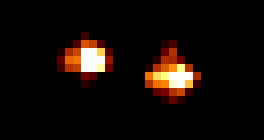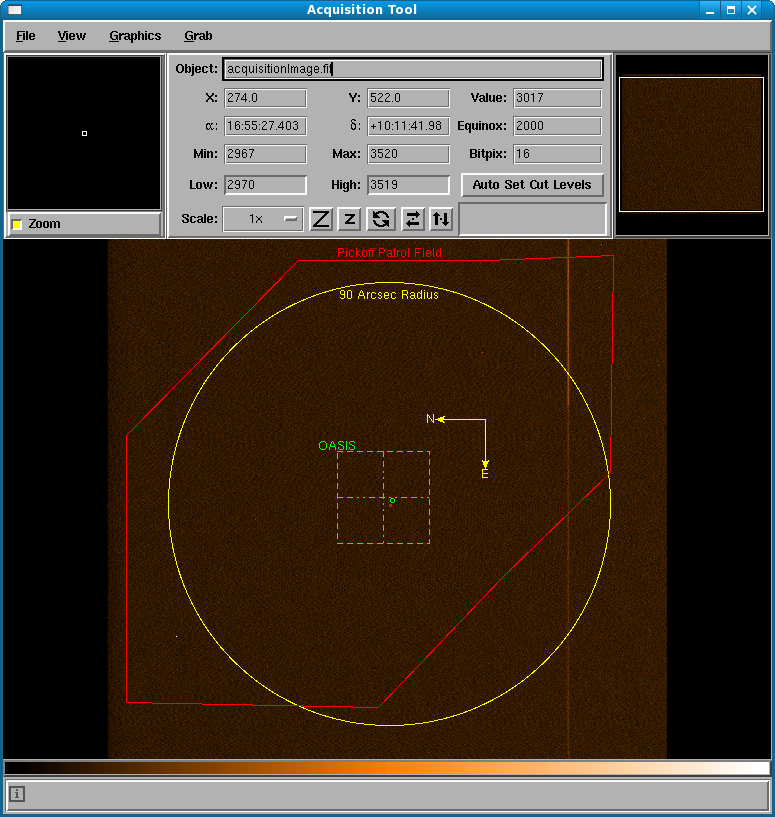Planning NAOMI Observations
NAOMI observers will need to:
The guide star can be the target itself, if the latter is sufficiently
bright and sufficiently pointlike (< 1.5 arcsec, say, to be smaller
than the sub-aperture guide boxes on the wavefront sensor).
NAOMI has successfully guided on the nuclei of galaxies.
For predictions of AO correction as a function of guide-star mag,
see the
NAOMI performance page.
There should be no stars of similar magnitude within ~ 5 arcsec of the
guide star, to avoid confusing the wavefront sensor.
The H-band image below is of a guide star R = 11 which turned out to be
a 0.5-arcsec double. The wavefront sensor guided on
this star with no problems, delivering FWHM 0.16 arcsec.

Use Roy Ostensen's
guide-star finder to search for
possible guide stars close to each of a list
of candidates.
Star counts, as functions of apparent mag and
galactic latitude, can be found in Allen's 'Astrophysical Quantities'.
For tip-tilt mode (guiding only, i.e. no AO correction), a guide star V < 19.5
within 0.9-1.5 arcmin of the target depending on its position angle with
respect to the target, and
the telescope sky position angle, is required. The reason for the range
in useful guide star separations is that the "patrol field" within
which the pickoff probe can move is sharply curtailed in certain orientations.
The situation is depicted in the following image, which corresponds to
telescope sky position angle zero. The small green and
red circles in the centre of the image indicate the nominal science target acquisition
position on OASIS, and the nominal on-axis position of the pickoff probe,
respectively.

Therefore, with the sky position angle of the telescope at zero, the separation of useful guide stars over the entire south-east quadrant from the target
is reduced from 1.5-arcmin, e.g. to only ~0.9-arcmin directly SE of the target. In such cases
the guide object can still be acquired by appropriately changing the sky position angle of the telescope; increasing sky position angle corresponds
to a clockwise rotation of the cardinal directions in this image, so that
for sky position angle 90-degrees North is up and East is left. Conversely, when a
specific telescope sky position angle is requested, a guide object with target separation greater than ~0.9-arcmin, but less than 1.5-arcmin, may nonetheless be located beyond the limits of the
patrol field at the desired sky position angle, and so cannot be acquired. As
an illustrative example, a guide star at, say, 65-arcsec due South of its target cannot be
acquired in a telescope sky position angle of, say, 45-degrees.
This image shows the boundaries of the patrol
field in pixels of the AG3 acquisition camera, for which the pixel scale
is 0.407 arcsec/pixel.
Finally, the outer parts of the patrol field are vignetted, and due to this
guide stars which fall in the outer parts should ideally be brighter than
the V-limit of 19.5 mentioned above, to ensure reliable guiding. The
level of vignetting in the periphery of the patrol field has not been well
characterised, but in practice experience shows it's possible to guide on
stars brighter than V~18.5 as far as ~80-arcsec from their target,
even with thin cirrus present.
The AO-corrected PSF (point-spread function) typically comprises a
near-gaussian diffraction-limited core plus a faint blobby pattern
extending over a disk of similar radius to the uncorrected
seeing.
The form of the PSF varies strongly with radius from the guide star.
It also varies with position angle from the guide star,
with the major axis
usually pointing towards the guide star.
The PSF at the science target (if not coincident with the guide star),
can be estimated from the PSFs of nearby objects, but the density of
stars in the field is rarely high enough for this.
A better approach is to obtain separate
exposures of star pairs of similar separation and position angle
to the guide star and science target.
The separations should be similar within ~ 5 arcec, and the PA within
~ 30 deg.
The mag of one of the stars should be within ~ 0.2 mag that of the
guide star (this constraint can be relaxed for V < 10).
These PSF-calibration
exposures should be made every ~ 15 mins, close (~ degs) on the
sky to the target.
The dither pattern should be similar to that used for the science
observations, and the exposures should last at least 1 minute at
each dither point.
Use Roy Ostensen's
PSF star finder and
PSF star-pair finder to locate PSF stars and pairs
near specified positions on the sky.
Observing overheads with adaptive-optics systems are higher than
for normal observing, and these overheads should be included in the
request for time.
For acquisition of the guide star by the wave-front sensor,
observers should allow 5 - 10 minutes per target.
We believe, as of Jun 2003, that there is no settle time for the
AO system, after locking onto the guide star (the PSF measured
from the first exposure after closing the loop is similar to
that from later observations).
For dithered observations, allow ~ 7 sec per dither point (this is
for movement of the telescope, corresponding movement of the
guide-star pickoff probe, and closure of the AO loop), i.e. ~ 50 sec
for a 5-point dither.
INGRID itself takes ~ 1.5 sec to read out.
E.g. if a coaverage of 40 1-sec exposures is required at a given point
(to avoid saturation of the INGRID chip at ~ 25000 counts/pixel),
the overhead is ~ 60 sec, i.e. 150%.
Additional time should be allowed for calibration of the
point-spread function (PSF), if required.
The PSF delivered by an
AO system is a function of radius from the guide star,
but can be estimated by observing star pairs
of similar separation (to the guide star and target)
at frequent intervals during the night (~ every half hour).
For extended targets, offset sky exposures will also be required
(as for normal IR observing).
For a straightforward programme, and when long PSF-comparison exposures are
not required, the observing efficiency (fraction of night spent
exposing on science targets) can be high, e.g. 60% on the night
2003 Sep 10 (NAOMI/INGRID observations made by visiting observer
Maria Rosa Zapatero).
For non-AO spectroscopic observing, the observing efficiency at 4-m
telescopes is typically ~ 70%.
Exposures can be made with the AO loop open to check the natural seeing,
or if AO correction is not required.


